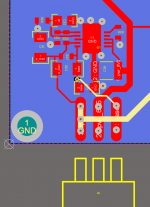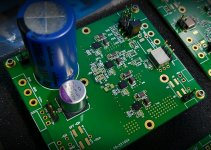Personally, I worry when I see too many people doing things like:
https://www.diyaudio.com/forums/dig...mate-weapon-fight-jitter-657.html#post6668751
The latest add-on for that is a reclocker board (fed by RPi GPIO bus style interconnects) that aims to produce the squarest of fast rise time square waves the designer can figure out how to make.
I have have repeatedly tried to point out that using the fastest possible rise times doesn't always make dacs sound their best. Apparently no one cares enough to do an experiment to find out though.
By the way, looks like your conspiracy theory pal must be in the business of fixing up rooms and selling speakers, since that is what he recently promoted. Yes, it all makes perfect sense now


Raspberry Pi GPIO? Not going to be a big problem at GHz. Maybe you weren't aware, but the GPIOs on those SoCs have adjustable drive strength and slew rate and are designed to be mostly idiot proof even in the highest settings. They don't have rise/fall times faster than LVC logic even from what I can see.
Conspiracy theory pal? I'm not sure about that... I try not to get into anyone's motives generally, though. I think it's a bit rich to call him a conspiracy theorist while making unsubstantiated and unverifiable claims all the time, though.
I think it's a bit rich to call him a conspiracy theorist while making unsubstantiated and unverifiable claims all the time, though.
You don't know what you are talking about, I'm planning to open my own speaker shop and room acoustic treatments company! Doesn't matter I haven't build a speaker in my life, all I know about room acoustics practice is that egg crates on the walls do a great job, and I don't have any tools to evaluate the acoustics, the SQ of everything I will do will be amazing, dare to challenge my ears
 .
.What do you think these regulator?
http://strawberry-linux.com/catalog/items?code=13451
http://strawberry-linux.com/catalog/items?code=13451
I can't read most of it, but I did see LT3045. The LT3045 is a very good regulator chip. Its reference is not particularly low noise, but its reference noise can be filtered off very effectively with one external capacitor. The buffer between the filtered reference and the output is quite good. See its datasheet for details.
How can you expect low voltage noise from a current source
with a Meg-Impedance? The capacitor is an unavoidable part
of the game. If you are into 1/f, 100uF tantalum seems to work.
Yes, larger than the DS says.
An output cap > the recommended 4u7 creates a noise peak.
Gerhard
with a Meg-Impedance? The capacitor is an unavoidable part
of the game. If you are into 1/f, 100uF tantalum seems to work.
Yes, larger than the DS says.
An output cap > the recommended 4u7 creates a noise peak.
Gerhard
Hi, any specific hint for input, baypass, output capacitor? For sense 100uf tantalum? I use tantalum polymer. Input output smd pps and pml or ceramic. Which value do you suggest What do you suggest for best analogue sound. I did not any impedance medurements, and you are welcome with your results. Thank you.
Who said anything about the noise voltage of a current source?
When you look at the ratio of the LT3045's reference current to the reference current's noise current density, it is not particularly good. Hence, using just a resistor instead of a resistor with a capacitor in parallel, the ratio of the reference voltage to its noise voltage density would not be very good either.
That is, the main features of the LT3045 are the good output buffer and the easy way to filter off the reference noise.
When you look at the ratio of the LT3045's reference current to the reference current's noise current density, it is not particularly good. Hence, using just a resistor instead of a resistor with a capacitor in parallel, the ratio of the reference voltage to its noise voltage density would not be very good either.
That is, the main features of the LT3045 are the good output buffer and the easy way to filter off the reference noise.
If you use the Google translation you can understand pretty much.I can't read most of it, ....
You did. The 3045's reference IS a current source that is driven intoWho said anything about the noise voltage of a current source?
a resistor. And it is precise. Small or large 0.5% Susumu thin film resistors
give usually 0.5% exact results. That tells us something about the
size of the source impedance without formally measuring it. The impedance
at this node is de facto Rset. And the voltage noise that we see is essentially
the thermal voltage noise of Rset. The capacitor is there to suppress it.
The large value of Rset helps to create a low frequency corner.
But at 20 Hz and below that runs into problems.
< https://flic.kr/p/Lu5GxL >
That is a LT3042 with a NPN for larger currents. The circuit is in the data sheet.
Noise is more or less the same as a 3042 without thermal help.
capacitors are X7R ceramic here. Sorry to burst that bubble. It does not take
elves who dance around it at midnight. There is no such thing as the
delicate sound of DC. (The Delicate Sound Of Thunder is OK.)
My regulators feed microwave oscillators where every fault is magnified
a million times.
The pic below is an alterative layout on 4 layers.
Gerhard
Attachments
My remark related to the current noise of the current reference, I thought that would be clear from the context. Apparently you still don't get it after I made it explicit in post #329, which amazes me as I know from your other posts that you must be very intelligent.
Anyway, I never measured the LT3045's noise, but looking at the datasheet:
Reference current RMS output noise, 10 Hz to 100 kHz: 6 nA RMS typical
That's 18.9746 pA/sqrt(Hz), the thermal noise current of a 45.7333 ohm resistor at 25 degrees Celsius. So unless the LT3045 is much better than its datasheet values or unless you never use it at output voltages above 4.57333 mV, the reference noise is definitely not dominated by thermal noise of Rset.
It is also generally not a very good value, just a middle-of-the-road bandgap noise level. See https://www.diyaudio.com/community/...oltage-regulators.359652/page-25#post-6946581 There are two mistakes in that post: the header should be "Updated unfiltered voltage or current reference noise list, extended with the LTC6655:", and "based on 1960's Electronics Letters article" should be "based on Hilbiber's article in the 1964 ISSCC Digest of Technical Papers".
Of course a major advantage of the LT3045 is that its reference noise can easily be filtered with a capacitor in parallel with Rset, but I think I already mentioned that twice.
Anyway, I never measured the LT3045's noise, but looking at the datasheet:
Reference current RMS output noise, 10 Hz to 100 kHz: 6 nA RMS typical
That's 18.9746 pA/sqrt(Hz), the thermal noise current of a 45.7333 ohm resistor at 25 degrees Celsius. So unless the LT3045 is much better than its datasheet values or unless you never use it at output voltages above 4.57333 mV, the reference noise is definitely not dominated by thermal noise of Rset.
It is also generally not a very good value, just a middle-of-the-road bandgap noise level. See https://www.diyaudio.com/community/...oltage-regulators.359652/page-25#post-6946581 There are two mistakes in that post: the header should be "Updated unfiltered voltage or current reference noise list, extended with the LTC6655:", and "based on 1960's Electronics Letters article" should be "based on Hilbiber's article in the 1964 ISSCC Digest of Technical Papers".
Of course a major advantage of the LT3045 is that its reference noise can easily be filtered with a capacitor in parallel with Rset, but I think I already mentioned that twice.
"Of course a major advantage of this car is that its axles can be augmented with tyres, but I think I already mentioned that twice."
The capacitor is fundamental to this design and the net result is that the LT3042 family is better wrt noise than its competition by 35 dB.
< https://flic.kr/p/CF3C9r >
(There is more on Flickr) left/right
ed. That embedding of Flicker contents seems to work here only partly.
The capacitor is fundamental to this design and the net result is that the LT3042 family is better wrt noise than its competition by 35 dB.
< https://flic.kr/p/CF3C9r >
(There is more on Flickr) left/right
ed. That embedding of Flicker contents seems to work here only partly.
Last edited:
Negative voltages - how?LT3045 is good for my hobbies.
View attachment 1103547
View attachment 1103548 View attachment 1103549
LT3094.Negative voltages - how?
I designed and fabricated it for a low phase noise frequency synthesizer circuit. It can be used with audio applications as well, ohh, it's damn luxury!
Attachments
- Home
- Source & Line
- Digital Line Level
- Low noise regulator for DAC & clock

